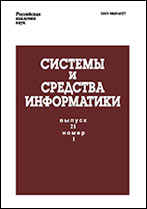|
Architecture of the tool for developing the functional hybrid intelligent systems with a heterogeneous visual field
A. V. Kolesnikovab, S. V. Listopadb
a Immanuel Kant Baltic Federal University, 14 A. Nevskogo Str., Kaliningrad 236041, Russian Federation
b Kaliningrad Branch of the Federal Research Center "Computer Science and Control" of the Russian Academy of Sciences, 5 Gostinaya Str., Kaliningrad 236000, Russian Federation
Abstract:
Hybrid intelligent systems integrating experts' knowledge models solve heterogeneous tasks (problems). At the same time, elements of hybrid intelligent systems interact using symbolic-logical models of knowledge, which significantly limit their capabilities in comparison with teams of experts who successfully argue both logically and figuratively. A typical architecture of hybrid intelligent systems that synthesize integrated methods for solving problems over a heterogeneous visual field and an architecture of the tool for developing such systems are proposed. Hybrid intelligent systems with a heterogeneous visual field alternately simulate collective verbal-symbolic and visual-figurative reasoning depending on the uncertainty of the decision-making situation. Visual-figurative reasoning allows the system to “see” an approximate solution of the problem which can be refined later by the methods of verbal-symbolic reasoning.
Keywords:
hybrid intelligent system; heterogeneous visual field; visual reasoning; visual management.
Received: 30.09.2017
Citation:
A. V. Kolesnikov, S. V. Listopad, “Architecture of the tool for developing the functional hybrid intelligent systems with a heterogeneous visual field”, Sistemy i Sredstva Inform., 27:4 (2017), 95–108
Linking options:
https://www.mathnet.ru/eng/ssi546 https://www.mathnet.ru/eng/ssi/v27/i4/p95
|

|




 Contact us:
Contact us: Terms of Use
Terms of Use
 Registration to the website
Registration to the website Logotypes
Logotypes








 Citation in format
Citation in format 